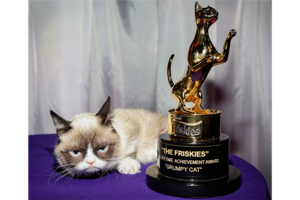Why do we love grumpy animal memes? Science explains.
Grumpy looking animals, such as the Grumpy Cat and, now, Grumpy Dog, can exploit our brains' natural tendency to seek out novelty, as well as big eyes.

Global Internet sensation Grumpy Cat wins the Lifetime Achievement Award at 'The Friskies' Award Show, in New York in 2013 .
John Minchillo/AP Images for Friskies
Why can't we seem to get enough of Grumpy Cat and now Earl the grumpy puppy? It comes down to eye contact, nurturing, and a need for variety, say experts.
Grumpy Cat, with his flat face and bulbous eyes, has become a one-cat cottage industry, appearing on everything from mugs to the movie “Grumpy Cat’s Worst Christmas Ever” (2014).
But now, Instagram user Derek Bloomfield’s moody-looking pooch, Earl, is online to rival the pouting puss on social media.
The images quickly made the leap across platforms to Twitter.
In an interview, Roger Dooley, author of Brainfluence: 100 Ways to Persuade and Convince Consumers with Neuromarketing and the popular blog Neuromarketing, says the social media appeal of these surly creatures stems from “ a shift in attractiveness that signals a novelty factor is involved, that people are tired of a stock photo of a cute cat or cute dog.”
“Even animal lovers get tired of looking at the same old thing,” Mr. Dooley says. “People can only stand so much cuteness.”
Also, he says, “If you can assign this sort of unexpected emotion to an animal, it’s effective. I think we don’t expect our animals to be grumpy, so as a result you have that novelty factor at work too.”
Dooley engages in consumer neuroscience, which seeks to use scientific discoveries about the brain to determine the motivations behind consumer choices.
It’s not hard to find evidence of the level of engagement humans have with images of cats and dogs. A simple Google search on cat images yields 590,000,000 results, of which 6,790,000 results are of just Grumpy Cat. The same search for dog images yields 556,000,000 results, 4,700,000 of which are of grumpy dogs.
Dooley says that cute animals have always been an effective marketing tool, a practice he attributes to both the “anthropomorphizing of animals and the fact that humans are attracted to larger eyes, which animals have.”
Brad Duchaine, Associate Professor Department of Psychological and Brain Sciences at Dartmouth College in Hanover, New Hampshire who works on face processing, says in an interview that in these cases of Grumpy Cat and Earl, “The eyes are driving a lot of the signal.”
“When we look at a cat face we’re applying the same things we do when looking at a human face,” he says. “The eyes are narrowed and the mouth is curved downward. We read that as the cat having a kind of complex emotion like we have. We’re attracted to it the way we would be to a grumpy faced human or a kid making that face we’d think it was funny.”
Looking at the photos of Earl, Duchaine exclaims, “Oh, yeah, that puppy is grumpy. And it looks like an old man too.”
“I think it’s the eyes and the mouth driving it,” he says. “You can cover up everything else and with just the eyes and the mouth you get the signal of anger, grumpiness, pretty clearly.”
Another factor that may be driving the almost physical pull of these animal images is the that humans are attracted to larger eyes thanks to a built in trigger that sensitizes us to our young.
“It’s a signal for youth and babies have large eyes relative to their heads,” Duchaine explains. “That’s something you see in all juvenile animals and it’s something we find appealing, maybe because we’ve been designed to respond to juveniles – caretaking.”
A good side-by-side comparison might be the popularity of grumpy-faced toddlers to grumpy animals. A Google search for baby images yields 912,000,000 results, while looking for grumpy baby pictures furnishes 4,010,000 results (just a shy of today’s 4,700,000 Grumpy Dog results).
While the grumpy animal trend is unlikely to last very long, human nature, marketing and neuroscience combine to keep these favorites in the back of our minds.
“This is just an interesting meme that will eventually get overworked and die back to a lower level,” Dooley concludes. “I think at the moment, whenever you’ve got one of these memes that sort of explode they have a period of strong growth and eventually the shelf-life becomes a little bit more limited. Not that they ever go away.”
Paul Nelson, creator of News and Cats on Tumblr has resisted the siren song of the grumpy, "I never have posted Grumpy Cat or anything related to him, though I admit some of the memes are good for a chuckle. But I prefer cat posts that are good-natured fun and, I guess at the heart of it, more positive in that they celebrate the hilarity of cats and cat ownership."


